
Point Values
The numberof points awarded for hitting a specific colour or “ring” on a target depends on several factors
- whether you are shooting indoors or outdoors
- whether you are shooting an Imperial or Metric round
- what type of bow you are using
The various scoring systems are shown below. Although they may look complicated at first there are really only two main systems to learn – Imperial or Metric (with a very slight variation between the indoor and outdoor Metric scores).
If you shoot compound there is an additional indoor scoring system which makes it harder for compounds to score a 10.
LINE CUTTERS
One thing is common to all the scoring systems and round types.
If your arrow cuts the line between two of the rings, however slightly, you always get the higher score. That’s why you see some people changing from thin carbon fibre to fat aluminium arrows for indoor shoots!
Outdoor Shooting
TARGET FACES
Outdoor rounds are always shot on the standard 5 colour face. The face can be either 122cm or 80cm across, depending on the type of round being shot.
All Imperial Rounds (those shown in yards e.g. York, Albion, National etc) are all shot on the 122cm face.
Metric rounds (those shown in metres e.g. FITA 70, Long Metric etc) may be shot on either the 122cm face, the 80cm face or a combination of both, depending on the round.
Outdoor – Scoring GNAS Imperial Rounds
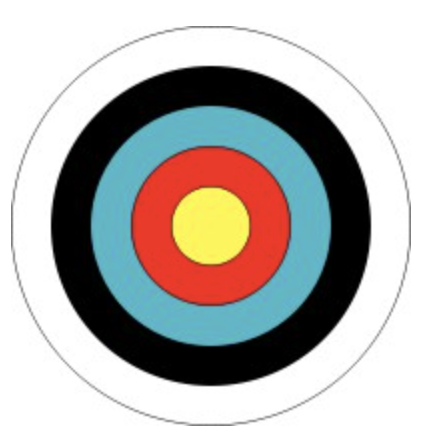
Outdoor – Scoring FITA and GNAS Metric Rounds
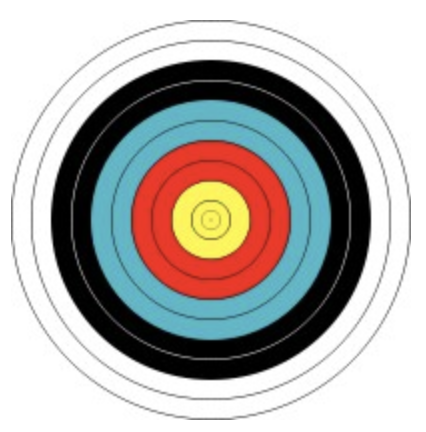
This is the only system where the innermost gold counts as 10 points but is marked as an X on the scorecard. The number of Xs is used to resolve tie breaks.
Indoor Shooting
TARGET FACES
Again, most of the Metric (shown in metres) and Imperial (shown in yards) are shot on the standard 5 colour face. The face may be 80cm, 60cm or 40cm depending on the round.
There are also two variations of this face
- The FITA three spot used for some FITA rounds
- The Vegas face used for one specific round.
Both these faces have three targets which include only the inner blue to gold rings of the standard target. The possible score range is therefore 6-10. Each of three arrows is shot at a different one of the three targets, primarily to prevent arrow damage from “Robin Hood” shots.
There is also a special black and white face which is only ever used in shooting the Worcester round. This has a possible score range of 1-5 (see below).
Indoor – Recurve and Longbows
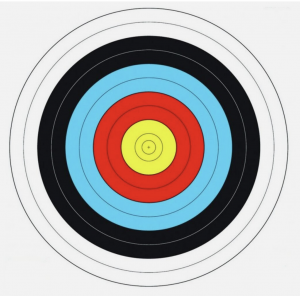 The standard 5 colour face | 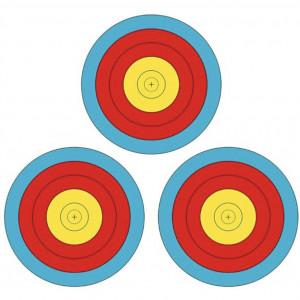 The Vegas triple face |
 FITA 3 spot | 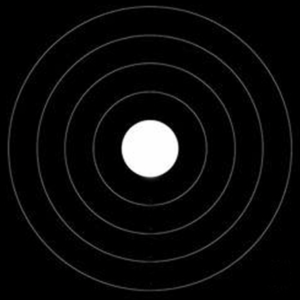 Worcester face |
 All indoor rounds shot with a recurve or longbow use the above 1-10 scoring system where the both the inner and innermost golds count as 10.
All indoor rounds shot with a recurve or longbow use the above 1-10 scoring system where the both the inner and innermost golds count as 10.
Indoor – Compound Bows Only

Indoor rounds shot with a compound bow use the above scoring system where both the outer and inner golds count as 9 and only the innermost gold counts as 10.
Indoor – Worcester Round (all bows)

The indoor Worcester round is an exception to the coloured scoring faces. It is shot on a special target with 4 black outer rings and a white inner ring. The outer rings score 1-4 with the inner ring scoring five. It is also the only round where you shoot 5 arrows per end.
The Scorepad
Regardless of the type of round you are shooting or the brand of scorepad you are using your score is recorded in a similar way.
- Every time you collect your arrows, your scores are recorded from highest to lowest.
- For example if your three indoor arrows scored a 4 and two 8s you would record this as 8,8,4. If your next three scored two 5s and a 9 you would record this as 9,5,5 and your scores would read 8,8,4,9,5,5.
- If six outdoor arrows scored three 9s, a miss, a 5 and a 3 you would record this as 9,9,9,5,3,M.
- Write these from left to right in the boxes provided.
- Each “End” (six arrows) add up the score for those six arrows and write it in the “End” box.
- Repeat the process for the next six arrows.
- Add up the number of “Hits” (i.e. scoring arrows only) for those twelve arrows and write that in the “H” box.
- Add up the number of “Golds” (i.e. 9s on Imperial scoring and 10s on Metric) for those twelve arrows and write that in the “G” box.
- Add up the score for both the “Ends” on that line (i.e. the total score for the twelve arrows) and write that in the “Dozen” box.
- The final box on the line is the “R/T” or Running Total which for the first line is the same as the “Dozen” figure.
That completes your scoring for your first dozen arrows and finishes the first line of your scoresheet.
- Repeat these steps for the next dozen arrows to complete the second line. This time your “R/T” running total will be the sum of the first two “Dozen” scores.
- Repeat the process for the correct number of arrows in the round you are shooting.
- Once you have finshed the required number of arrows, add up the total number of Hits and Golds and record these, together with your total score, in the appropriate “Totals” boxes at the bottom of the sheet
As an example, an archer shooting a “Long National” round must shoot the following combination of arrows
- four dozen arrows at 80 yards
- two dozen arrows at 60 yards
Note that as this is an Imperial round, the only potential scores are 1,3,5,7 & 9 and that 9 counts as a “Gold”.
A few basic but important notes (especially for competitions!)
- Don’t touch the arrows or the target face until all the arrows have been recorded.
- Point to the arrow nocks as you call each arrow.
- If you are calling out your scores for someone else to record (e.g. a competition), call them in batches of three, e.g. 9,9,9 (pause) 5,3,Miss.
- If there is any sort of dispute over the score of an arrow that the archers on the target can’t agree on, don’t pull any arrows until the field captain or judge has been called and made their decision.
- Complete the scoring before collecting any arrows that overshot the target (obviously collect any that fell short as you approach the target – before someone stands on them!)
